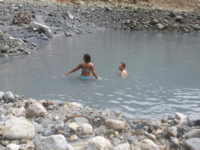Menu
Swimming in the boiling lake when it goes cold is not a good idea, no matter how enticing or gratifying it may seem.
Dominica's Boiling Lake is situated in the Morne Trois Pitons National Park, Dominica's World Heritage site. It is a flooded fumarole 6.5 miles (10.5 km) east of Roseau, Dominica. It is filled with bubbling greyish-blue water that is usually enveloped in a cloud of vapour. The lake is approximately 200 feet (61 m) to 250 feet (76 m) across.
Read more: A caution against swimming in Dominica's Boiling Lake
S
oufriere Hills Volcano on the island of Montserrat in the Caribbean became active on July 18, 1995. This was the first eruption of the volcano in historic time.
Villagers on Montserrat reported loud rumbling noises, a light ashfall, and a strong sulfurous odor on July 18. The eruption was preceded by three years of elevated seismic activity and a more intense earthquake swarm that began on July 14. The initial eruption was apparently a small phreatic (steam) event which produced minor ash that was distributed about the island by the wind. Satellite imagery analyzed by scientists at NOAA showed no signs of this eruption plume, as would be expected for such a small event. On July 19, observers confirmed that small steam explosions were occurring in an area about 1.5 kilometers northeast from the summit. The explosions were spaced about 20 minutes apart and sent ash and steam about 40 meters high. On July 22, light ashfall occurred in the capital of Plymouth, located about four kilometers west of the summit, and in villages to the southwest of the summit. [1]
Before 1995, Montserrat was a relatively quiet tourist destination -- a British Overseas Territory with a population of 11,000.
At 11:43 am local time on June 7, 1692, the city of Port Royal, Jamaica was hit by a powerful magnitude 7.7 earthquake. The earthquake caused a landslide which forced a section of the harbour to collapse into deeper water and this generated a tsunami which destroyed ninety percent of the buildings in the city.
Immediately after the main shock, a further two thirds of the city slipped into the sea and within two minutes, the city was covered with water. Approximately 2,000 were drowned; about 1,000 more perished from the earthquake.
On August 4, 1946, at 1:51 pm near Samaná, Dominican Republic, the earth shook - hard. Residents did not know that they what they were about to experience would be entered into the history books as one of the Caribbean's deadliest tsunami.
The earthquake measured a whopping Ms8.1 and together with the tsunami which followed, caused widespread damage across the island of Hispaniola.
On Wednesday, 8th February, 1843, the very day after the meeting of the Vestry, the island was visited by a most terrific and destructive Earthquake. . . .
Everyone within the Church after the first shock was compelled to escape for their lives. The Tower was rent from the top to the bottom, the north dial of the clock precipitated to the ground beneath with a dreadful crash, and the east parapet wall of the Tower thrown upon the roof of the Church. Almost the whole of the north east wall of the north gallery fell out in a mass. The north east wall was protruded beyond the perpendicular. . . .
Thus within the space of three minutes, the Church was reduced to a pile of crumbling ruins, the walls that were left standing being rent in every part, the main roof only remaining sound, being supported by the hardwood pillars."





